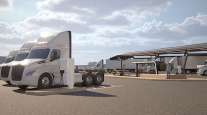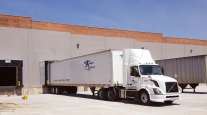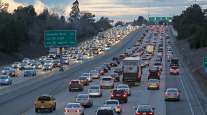San Gabriel Valley Tribune, West Covina, Calif.
California Pollution Rule Aimed at Logistics Upheld by Judge

[Stay on top of transportation news: Get TTNews in your inbox.]
A judge has denied a challenge to an air-quality enforcer’s landmark rule intended to clear Southern California skies of toxic exhaust tied to the logistics industry.
The federal court ruling comes as the South Coast Air Quality Management District announced Dec. 19 that it issued more than 100 violations to warehouses that weren’t complying with its Warehouse Indirect Source Rule.
The ruling, issued Dec. 14 in the Central District of California court, rebuffs objections by the trucking industry and airlines to the district’s program to enforce its rule, billed as a critical strategy to curb pollution from warehouse-bound diesel trucks.
In his 35-page ruling, Judge John A. Kronstadt rejected arguments by the California Trucking Association and the trade group Airlines for America that the rule, approved in 2021, is superseded by the 53-year-old federal Clean Air Act.
Despite plaintiffs’ arguments that “air pollution is not one of the traditional domains of state regulation,” the Supreme Court and federal Ninth Circuit appeals court “have already held that the control of air pollution is an activity that is traditionally within the state police power,” Kronstadt’s ruling read.
The judge also rejected claims that the rule would force warehouse owners to buy electric vehicles.
The state of California, the Sierra Club and other environmental groups intervened on the district’s behalf to defend the rule. Sierra Club Field Manager Yassi Kavezade lauded Kronstadt’s ruling.
“This ruling secures vital health protections for over 17 million Californians breathing dirty air and represents the culmination of years of tireless organizing by Sierra Club and our environmental justice partners,” Kavezade said in a release. “Warehouses can no longer pollute with impunity, poisoning our most vulnerable communities.”
ERoad's Craig Marris gives advice on carving out a practical, effective road map to a greener and more efficient fleet. Tune in above or by going to RoadSigns.ttnews.com.
A trucking association spokesperson did not immediately respond to a request for comment Dec. 19 while an Airlines for America spokesperson declined to comment. The ruling could be appealed.
Thanks to its proximity to the ports of Los Angeles and Long Beach, its nexus of interstates and freight rail lines, plenty of flat, cheap and vacant land and a blue-collar workforce, the Inland Empire has become a major logistics hub, with an estimated 1 billion square feet of sleek-walled warehouses filling the horizon and employing thousands of workers.
Logistics growth, fueled by an online shopping boom that went on steroids during the COVID-19 pandemic, provides paths to college degrees and bigger paychecks for warehouse workers, who support non-logistics jobs through their earnings, industry advocates say.
Supplying those warehouses are a steady stream of diesel-powered tractor trailers. Airborne emissions from those trucks have been linked by public health agencies to cancer, dementia, asthma and other health problems.
The governing board of the air-quality district — a public agency responsible for air quality in Orange County and urban areas of Los Angeles, Riverside and San Bernardino counties — approved the warehouse rule in 2021.
It sets up a system through which warehouses choose from a menu of options — installing rooftop solar panels and using zero-emission or near-zero-emission trucks, for example — to score a required number of annual points based on calculations involving the number of truck trips a warehouse generates.
In lieu of earning points, warehouse owners can pay a mitigation fee that’s used to buy clean trucks, electric vehicle charging stations and clean fuel infrastructure in communities near the warehouse that paid the fee. The rule applies to warehouses more than 100,000 square feet in size.
Want more news? Listen to today's daily briefing above or go here for more info
A district analysis found it could cost as much as $979 million to implement the rule and that 11,100 jobs from 2022 to 2031 potentially won’t be created as warehouses switch to clean-emission technologies.
At the same time, district officials said the rule will cut nitrogen oxide emissions by 1½ to 3 tons a day, or 10% to 15% by 2031, save 150 to 300 lives and result in 2,500 to 5,800 fewer asthma attacks, 9,000 to 20,000 fewer work loss days and public health benefits worth $1.2 billion to $2.7 billion.
In September, the district announced that roughly 1,400 of the 2,000 warehouses covered by the rule weren’t in compliance.
District officials at the time said they would start cracking down on violators. On Dec. 19, the district announced its inspectors visited more than 500 warehouses and issued 109 notices of violation in Los Angeles, Orange, Riverside and San Bernardino counties.
“It is critical to reduce emissions from sources associated with warehouse operations,” district Executive Officer Wayne Nastri said in a release. “Our enforcement team is actively working to ensure that all warehouses subject to our Indirect Source Rule comply with their obligations in order to protect the health of all residents in our region, including those living closest to these facilities.”
Distributed by Tribune Content Agency, LLC





